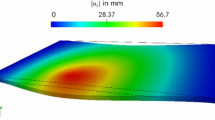Abstract
We propose a constructive introduction of the objective time derivatives based on the formulation of solid mechanics as a simple Lagrangian system. This enables to distinguish between deformation rates, which are in principle Lie derivatives, and stress rates, which are actually covariant derivatives along a curve representing a deformation process. Besides, the role of Daleckii–Krein formula in understanding the theory with generalized strains is highlighted, and a special attention will be paid to the logarithmic time derivative.
Similar content being viewed by others
References
Abraham, R., Marsden, J.E.: Foundations of Mechanics. Addison-Wesley Publishing Company, Redwood City (1987)
Abraham, R., Marsden, J.E., Ratiu, T.S.: Manifolds, Tensor Analysis, and Applications Applied Mathematical Sciences. Springer, Berlin (1988)
Arnold, V.I.: Mathematical Methods of Classical Mechanics. Graduate Texts in Mathematics. Springer, Berlin (1997)
Barbour, J.B.: On general covariance and best matching. In: Callender, C., Huggett, N. (eds.) Physics Meets Philosophy at the Planck Scale: Contemporary Theories in Quantum Gravity, pp. 199–212. Cambridge University Press, Cambridge (2001)
Birkhoff, G., Bennett, M.K.: Felix Klein and his “Erlanger Programm”. University of Minnesota Press, Minneapolis. Retrieved from the University of Minnesota Digital Conservancy. http://hdl.handle.net/11299/185660 (1988)
Bhatia, R.: Positive Definite Matrices. Princeton University Press, Princeton (2007)
Bruhns, O., Xiao, H., Meyers, A.: New results for the spin of the Eulerian triad and the logarithmic spin and rate. Acta Mech. 155, 95–109 (2002)
Carlson, D.E., Hoger, A.: The derivative of a tensor-valued function of a tensor. Q. Appl. Math. 44, 409–423 (1986)
Dieci, L., Eirola, T.: On smooth decompositions of matrices. SIAM J. Matrix Anal. Appl. 20, 800–819 (1999)
Epstein, M., Segev, R.: Differentiable manifolds and the principle of virtual work in continuum mechanics. J. Math. Phys. 21, 1243–1245 (1980)
Fiala, Z.: Geometrical setting of solid mechanics. Ann. Phys. 326, 1983–1997 (2011)
Fiala, Z.: Evolution equation of Lie-type for finite deformations, time-discrete integration, and incremental methods. Acta Mech. 226, 17–35 (2015)
Fiala, Z.: Geometry of finite deformations and time-incremental analysis. Int. J. Nonlinear Mech. 81, 230–244 (2016)
Fiala, Z.: Evolution equation of Lie-type for finite deformations, and its time-discrete integration. In: Murphy, C. (ed.) Emerging Concepts in Evolution Equations, pp. 1–30. Nova Science, Hauppauge, NY (2017)
Frankel, T.: The Geometry of Physics. An Introduction. Cambridge University Press, Cambridge (1997)
Graban, K., Schweickert, E., Martin, R.J., Neff, P.: A commented translation of Hans Richter’s early work “The isotropic law of elasticity”. Math. Mech. Solids 24, 2649–2660 (2019)
Hill, R.: On the constitutive inequalities for simple materials—I. J. Mech. Phys. Solids 16, 229–242 (1968)
Holm, D.D.: Geometric Mechanics. Part I: Dynamics and Symmetry. Part II: Rotating, Translating and Rolling. Imperial College Press, London (2008)
Horn, R.A.: The Hadamard product. In: Charles, R.J. (ed.) Matrix Theory and Applications. Proceeding of Symposia in Applied Mathematics, vol. 40, pp. 87–169. AMS, Providence, RI (1990)
Horn, R.A., Johnson, ChR: Topics in Matrix Analysis. Cambridge University Press, Cambridge (1991)
Korobeynikov, S.N.: Basis-free expressions for families of objective strain tensors, their rates, and conjugate stress tensors. Acta Mech. 229, 1061–1098 (2018)
Liu, I-S., Sampaio, R.: On objectivity and the principle of material frame-indifference. Mecánica Computacional XXXI. Number 9. Constitutive Modeling of Materials (B), 1553–1569 (2012)
Liu, I-S., Sampaio, R.: Remarks on material frame-indifference controversy. Acta Mech. 225, 331–348 (2014)
Marsden, J.E., Hughes, T.J.R.: Mathematical Foundations of Elasticity. Dover, New York (1993)
Marsden, J.E., Ratiu, T.S.: Introduction to Mechanics and Symmetry. Springer, New York (1999)
Meyers, A.: On the consistency of some Eulerian strain rates. ZAMM 79, 171–177 (1999)
Misner, Ch.W., Thorne, K.S., Wheeler, J.A.: Gravitation. W.H. Freeman and Company, San Francisco (1973)
Neff, P., Graban, K., Schweickert, E., Martin, R.J.: The axiomatic introduction of arbitrary strain tensors by Hans Richter—a commented translation of “Strain tensor, strain deviator and stress tensor for finite deformations”. Math. Mech. Solids
Noll, W., Seguin, B.: Basic concepts of thermomechanics. J. Elast. 101, 121–151 (2010)
Norris, A.N.: Eulerian conjugate stress and strain. J. Mech. Mater. Struct. 3, 243–260 (2008)
Prager, W.: An elementary discussion of definitions of stress rate. Q. Appl. Math. 18, 403–407 (1961)
Trkovská, D.: Felix Klein and his Erlanger Programm. In: Šafránková, J., Pavlů, J. (eds.) WDS’07 Proceedings of Contributed Papers, Part I, pp. 251–256. Matfyzpress, Prague. http://bergeron.math.uqam.ca/wp-content/uploads/2016/08/Histoire_Klein.pdf (2007)
Xiao, H.: Unified explicit basis-free expressions for time rate and conjugate stress of an arbitrary Hill’s strain. Int. J. Solids Struct. 32, 3327–3340 (1995)
Xiao, H., Bruhns, O., Meyers, A.: Logarithmic strain, logarithmic spin and logarithmic rate. Acta Mech. 124, 89–105 (1997)
Xiao, H., Bruhns, O., Meyers, A.: Strain rates and material spins. J. Elast. 52, 1–41 (1998)
Acknowledgements
The support through the Institutional Project RVO: 68378297 is gratefully acknowledged.
Author information
Authors and Affiliations
Corresponding author
Additional information
Publisher's Note
Springer Nature remains neutral with regard to jurisdictional claims in published maps and institutional affiliations.
Rights and permissions
About this article
Cite this article
Fiala, Z. Objective time derivatives revised. Z. Angew. Math. Phys. 71, 4 (2020). https://doi.org/10.1007/s00033-019-1227-7
Received:
Revised:
Published:
DOI: https://doi.org/10.1007/s00033-019-1227-7
Keywords
- Finite deformations
- Simple Lagrangian system
- Objective time derivative
- Deformation rate
- Stress rate
- Logarithmic rate
- Daleckii–Krein formula



